 Optimizely Languages
Optimizely Languages
The Optimizely Digital Experience Platform contains many features to support you in your daily work. Depending on how your solution is set up, some features described in this documentation may not be available to you. Contact your system administrator to find out more. See Optimizely World for technical information.
The Optimizely Languages add-on manages languages and translations of content on multi-lingual websites. After an administrator installs and sets up the add-on Plug-in or module, developed by Optimizely or its partners, to extend the capabilities of Optimizely. Add-ons are installed by Optimizely developers., you can add Optimizely Languages as a gadget Small application component that is responsible for its own rendering and behavior, accessible from the dashboard or the panes in the Optimizely user interface. A gadget can contain functionality that you can use within the gadget interface or link away to other products integrated in Optimizely (for example, a direct link to CMS / Pages where you can use the classic editing view features). where you can activate new languages for your website, manage language branches, and work with translation.
The gadget provides an overview of the language setup for your sites, and you can compare language versions when translating content. It also has a built-in feature for automated translation of content, based on a third-party plug-in.
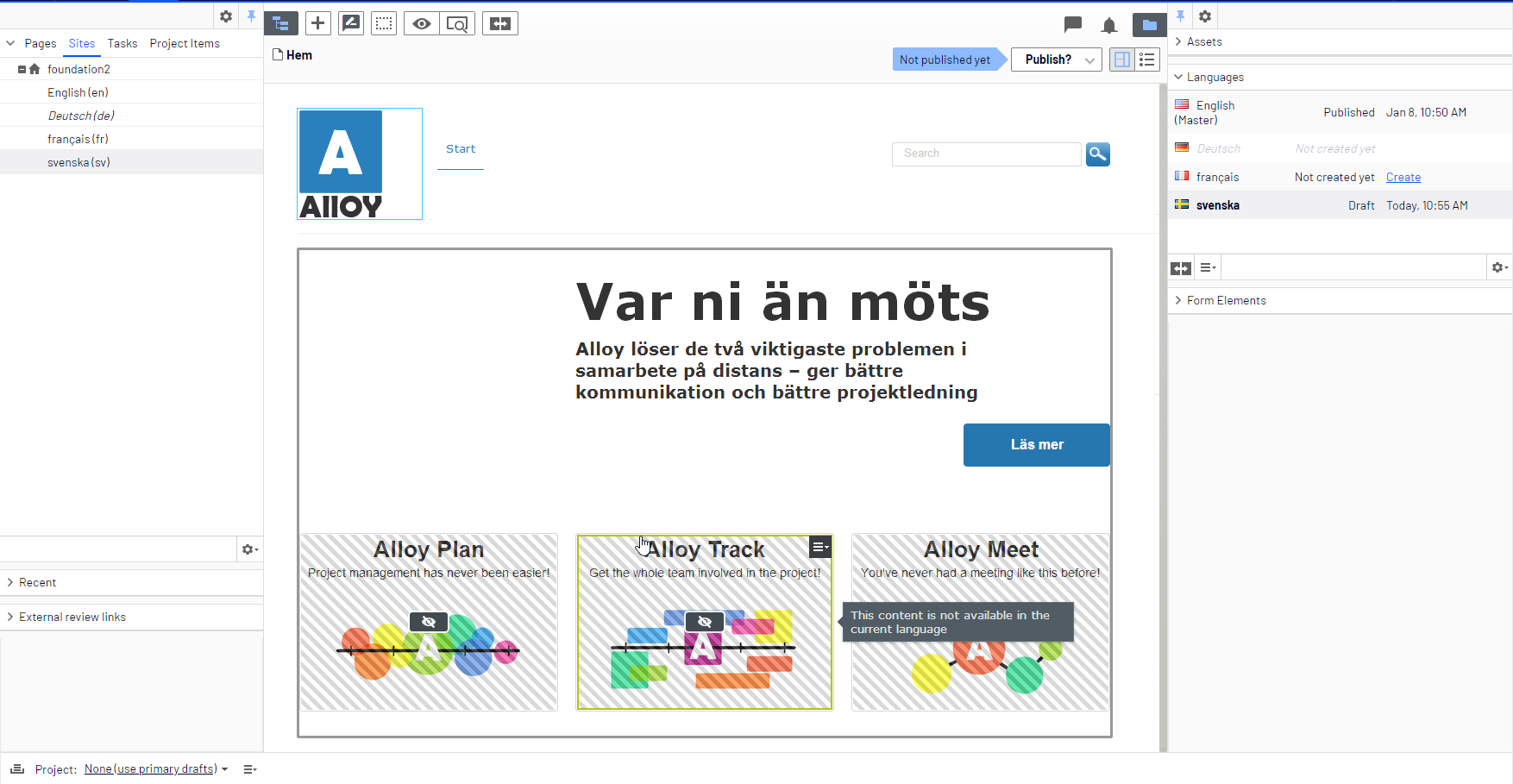
Setting up Optimizely Languages
Before you can create content in a language, a system administrator needs to add a language on the website and activate it.
Activating a language
- Select Manage Website Languages from the Optimizely Languages gadget Small application component that is responsible for its own rendering and behavior, accessible from the dashboard or the panes in the Optimizely user interface. A gadget can contain functionality that you can use within the gadget interface or link away to other products integrated in Optimizely (for example, a direct link to CMS / Pages where you can use the classic editing view features). options.
- Click the link for a language in the list. If a language is missing in the list, you can add it.
- Select Enabled to activate the language. Under Access level, you can provide access rights for a specific editor group, such as French editors, to work with the language. Each language is available to the Everyone group by default.
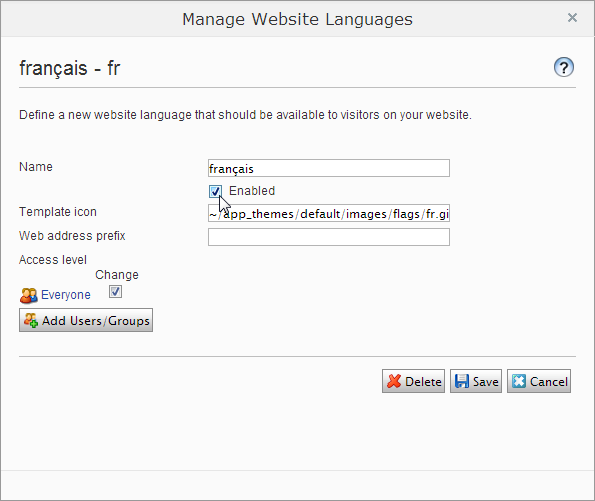
- Click Save to close the Manage Website Languages dialog box. The language is activated on the website and appears in the Optimizely Languages gadget, but it is not yet available for content creation.
Enabling a language for editing
By default inheritance from the parent page, the language is available for usage throughout the page tree structure, until changed. This means that when enabling a language for a parent page, the language is enabled also for subpages.
- Expand the page tree navigation in the left-hand pane and select the page from where you want the language setting to apply.
- In the Optimizely Languages gadget, select the language you want to activate.
- In the context menu, select Enable editing for [language].
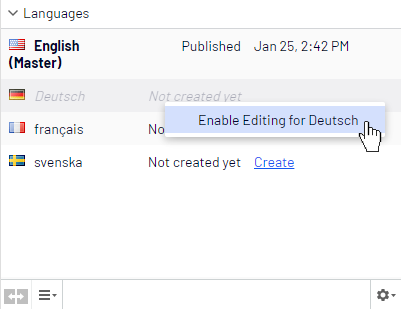
You can also enable languages for editing from the Manage Editable Languages for this Page dialog box available from the lower-left part of the Optimizely Languages gadget. This is also where you define fallback and replacement languages for the website. See Fallback Languages.
Connecting to the auto-translation service
- Subscribe to Azure, if you have not done so already.
- Register Translator from Cognitive Services.
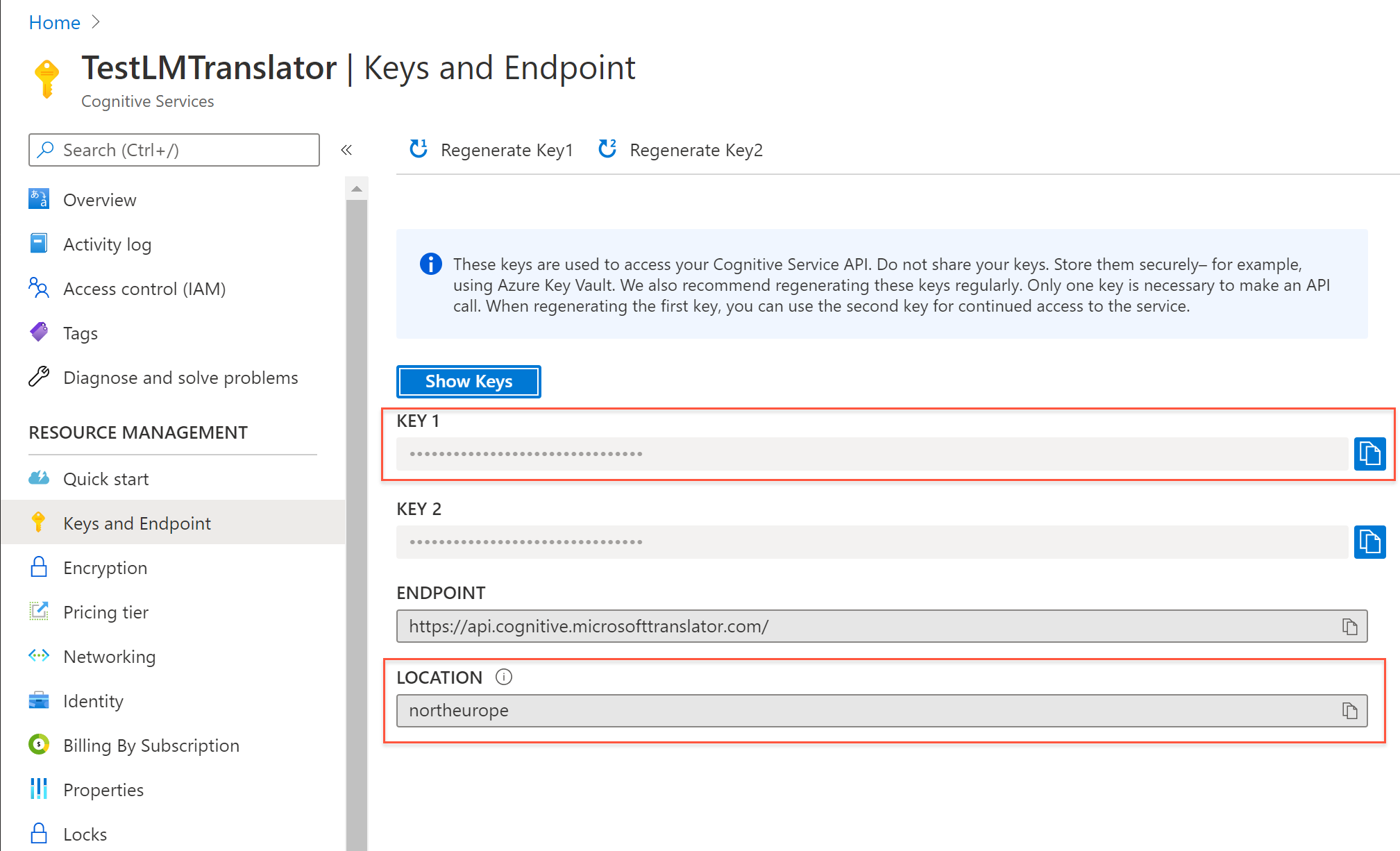
- Configure the auto-translate component in Optimizely Languages.
- Go to admin view > Config > Tool Settings > Language Manager.
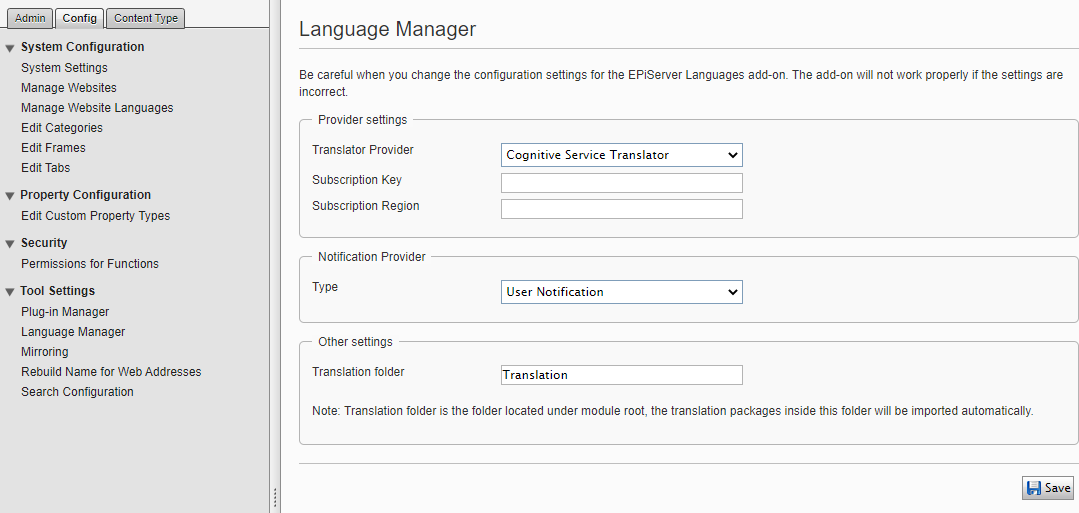
- Translator Provider. Select Cognitive Service Translator.
- Subscription Key. Enter the Microsoft subscription key (Key 1) from the Azure subscription service.
- Subscription Region. Enter the Location value from the Azure subscription service.
- Click Save.
- Go to admin view > Config > Tool Settings > Language Manager.
Using Optimizely Languages
Viewing language versions for a page
Viewing parts of a website in a selected language
- Select a page from the page tree in the left pane.
- To see pages that do not exist in the selected language, click the Show All Languages link at the bottom of the navigation pane. Pages that do not exist in the selected viewing language appear in italics; replacement or fallback languages (if applied) also appear.
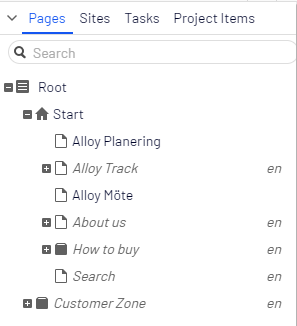
Translating content
Translate a page or block as follows:
- Select the page in the to be translated in the page tree, or open a block from the assets pane.
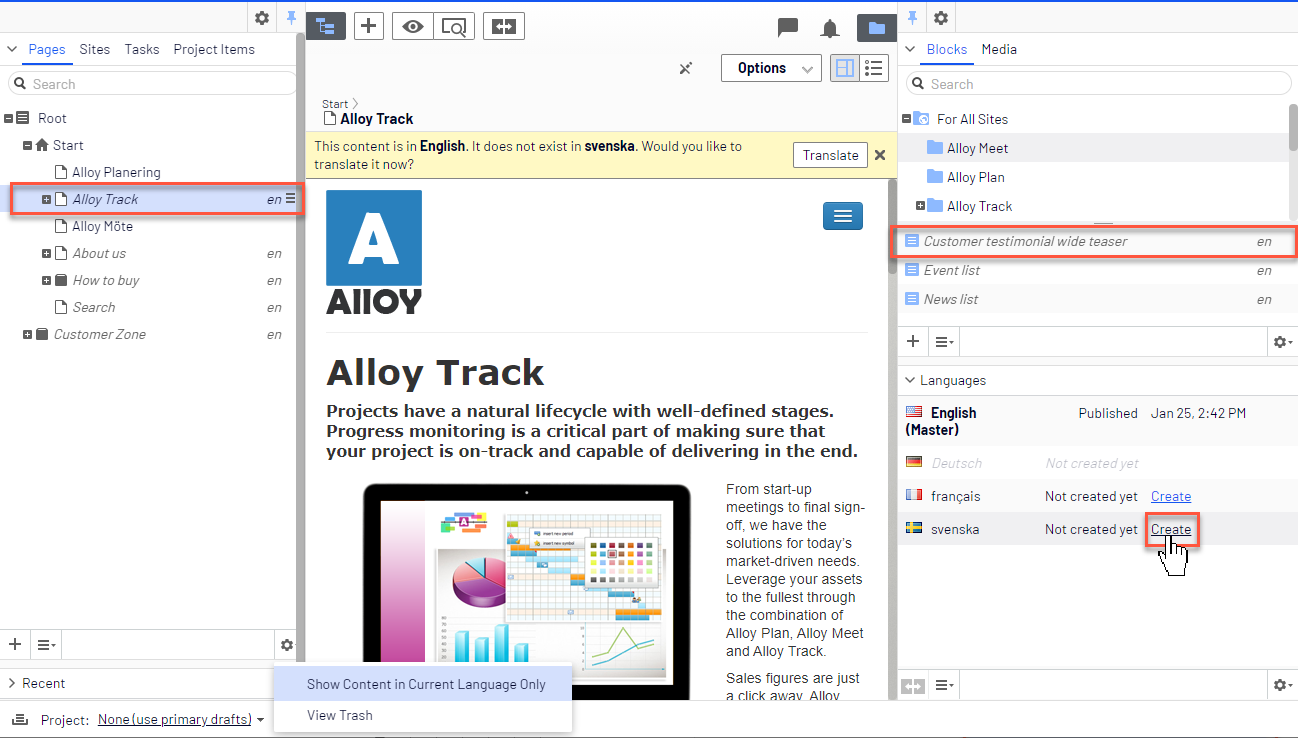
- Click Create in the Optimizely Languages gadget and select any of the following translation options:
- Auto-translate. Content is automatically translated from the master language. This option is available only if you have the auto-translate component properly configured on your website. See Configuring auto-translation.
Carefully review the result before publishing.
- Duplicate content. Copies content from the master language for you to manually translate.
- Start with a blank page. Creates a blank page or block with the title from the master language. You add translated content manually.
- Auto-translate. Content is automatically translated from the master language. This option is available only if you have the auto-translate component properly configured on your website. See Configuring auto-translation.
- Add translated content as appropriate.
- Review and publish the page or block according to the publishing flow in Optimizely CMS.
New language versions are draft versions, which you need to manually review and publish.
Replacing content with the master language
If you created content in a language other than the master language, you can replace the translated content with the master language content.
- Select the translated page in the page tree.
- Select the language you want to replace.
- Confirm the action by clicking Replace Content.
You cannot undo this action.
Creating a page in a different master language
To create a page that exists only in a specific master language:
- Select the desired target language in the Optimizely Languages gadget (or the tab in the navigation pane).
- Expand the page tree navigation in the left hand pane and select the parent page where you want to create the new page.
- Select the page type to be used and enter a page name.
- Review and publish the page according to the publishing flow in Optimizely CMS.
Comparing language versions
You can view a side-by-side comparison of a page in two different language versions, which helps you review auto-translated content, or manually translate content.
- Select an existing page to translate in the page tree.
- Select the desired translation language and the Compare with [master language] option in the Optimizely Languages gadget.
- Edit the content in the selected language. You cannot edit the master language page from here.
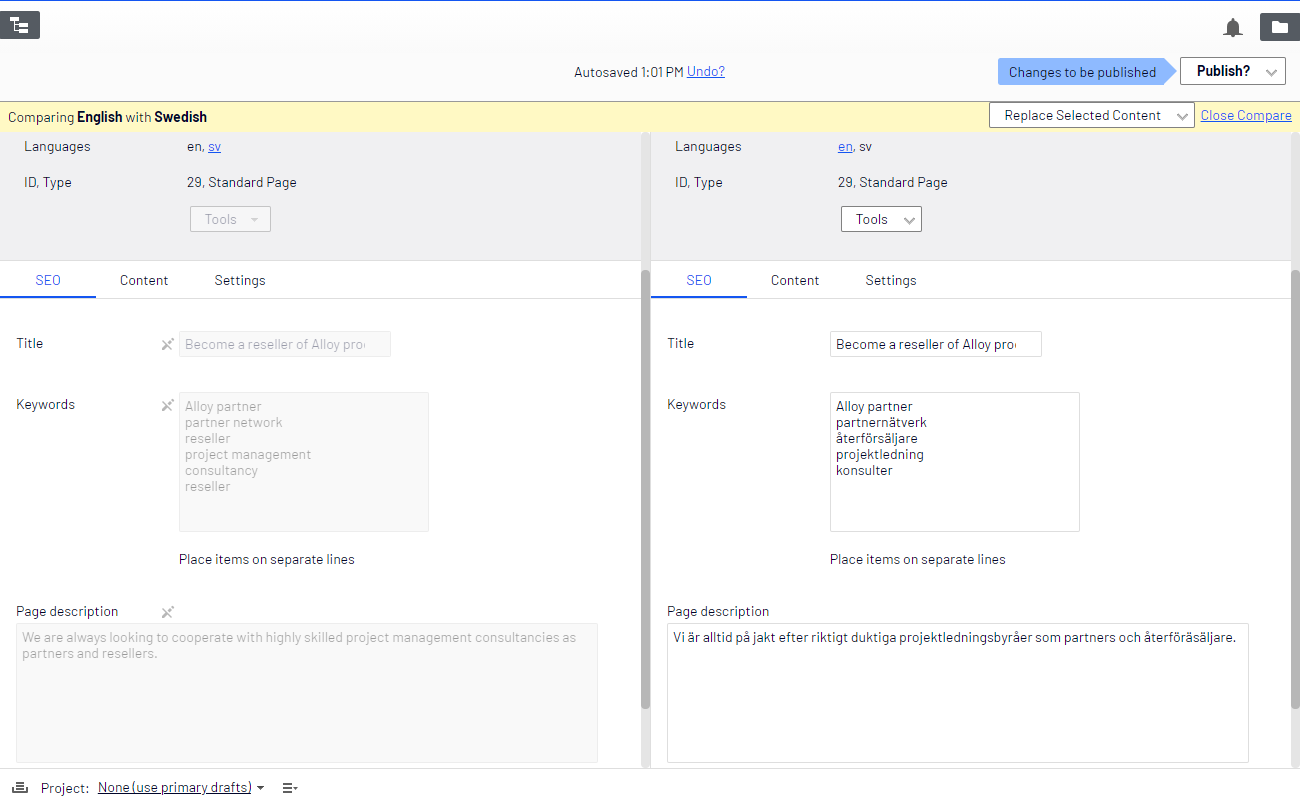
- Review and publish the page, or click Close Compare or Replace Selected Content.
Deleting a language version
You cannot undo this action.
- In the page tree, select the page from which you want to delete a language version.
- Open the Versions gadget, and select the desired language version.
- Confirm the deletion.
You cannot delete the master language version without deleting the entire page.
Importing and exporting XLIFF files
You can add a content item (such as a page or block) to a translation project by drag and drop and via its context menu. After adding content to a project, you can download a zip file containing the project items in XLIFF format (a format used by translation tools). The zip file can then be sent for translation.

When the translations for a project have been completed, you should receive the translated files back in a zip file. Upload the file to the server to import content back. After you upload the file to the server, the content is imported automatically by a scheduled job.
- A notification to the user appears in the user interface after importing a translation package.
- The translation folder is located under module root to store uploaded translation packages.
- The translation process affects only draft versions.
After you create a translation project, you can add content to it from the Languages context menu:
- Select New Project from the Project menu at the bottom of the browser to create a new project for the translation.

- Give the project a name and click . The project is automatically enabled.
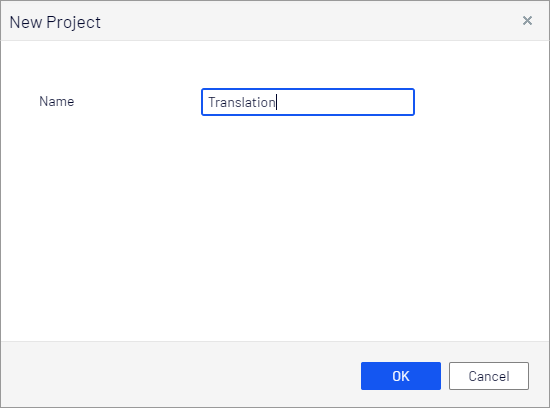
- In the page tree, select the page from which you want to translate. The Alloy Plan sample site page is used in this example.
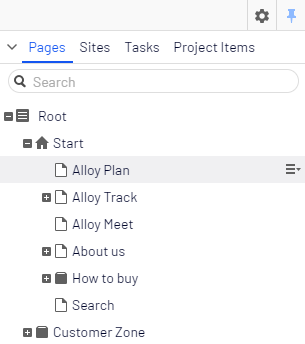
- In the Languages gadget, click Create next to the language you want to translate.
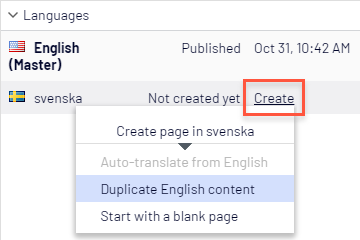
- Select the Duplicate English content menu item. You also can start with a blank page. The new version is automatically added to your translation project.
Do not publish the page during this step.
- If you have already created a target language version and want to add that to a translation project, select Add to Translation Project from the context menu. An Add to translation dialog box appears.
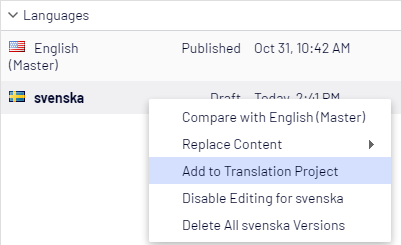
- Specify the content you want to add to your translation project.
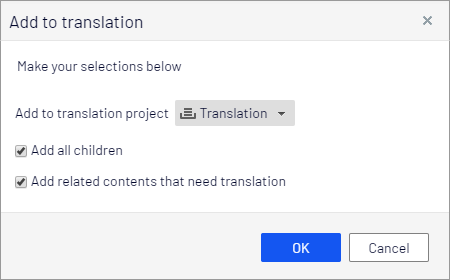
- Add to translation project. Select the project you want to work with.
- Add all children. Get all references to the descendent of the content and add to the project.
- Add related content that needs a translation. Add all related content items in the content to the project.
You can combine children and related content, included in the translation project. If they are already part of another project, you are notified of this.
- After you finish adding content to your translation project, go to the Project menu and click Overview.

- Select Options > Download Translation Package. A zip file containing all XLIFF format content is downloaded and you can send the package for tool translation.
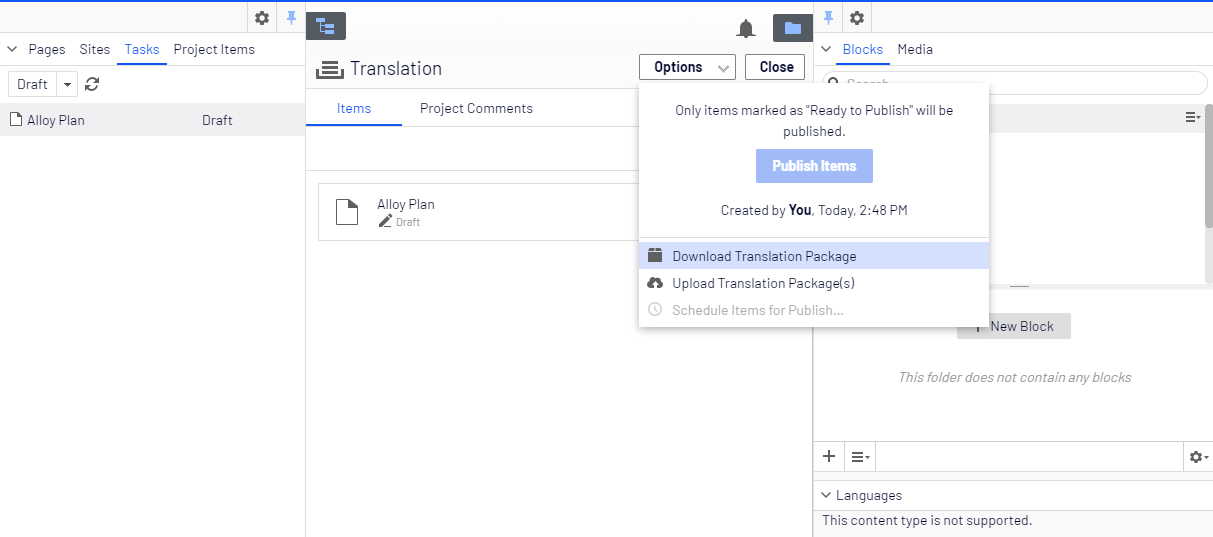
Import translation package
Before uploading the zip file, make sure it does not include any folders.
- When the translations for the project are done, enable your translation project and select Options > Upload Translation Package(s) to upload the file (in zip format) to the server and import content back.
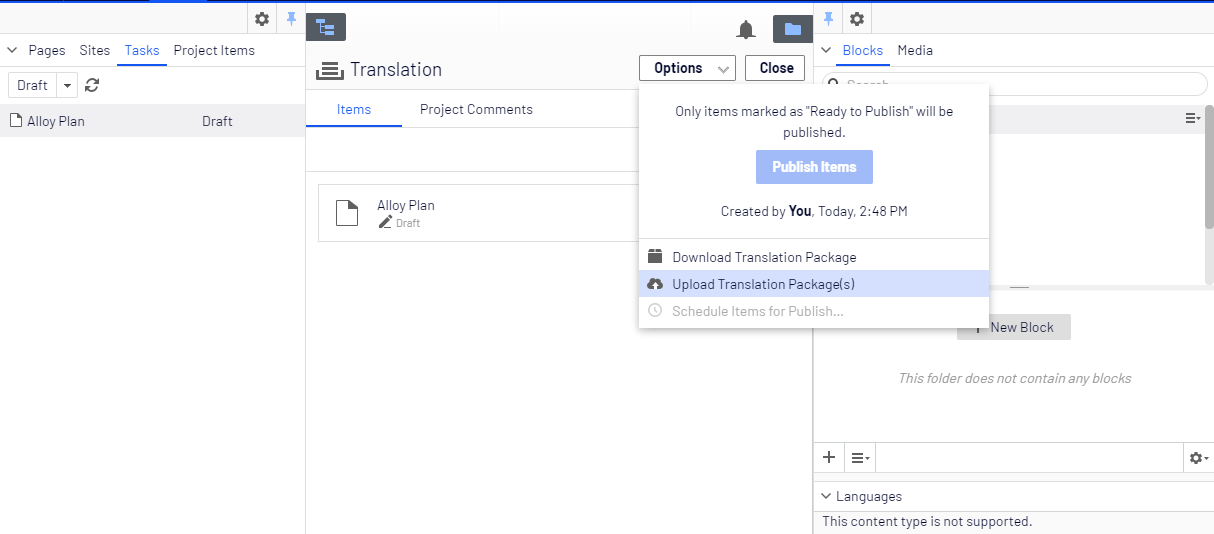
- After you upload the packages to the server, they are automatically imported by a scheduled job. If you want to start that process manually, go to admin view > Admin > Scheduled Jobs > Import Translation Packages > Start Manually.

A notification is also sent to the project owner that the translation project was imported.
